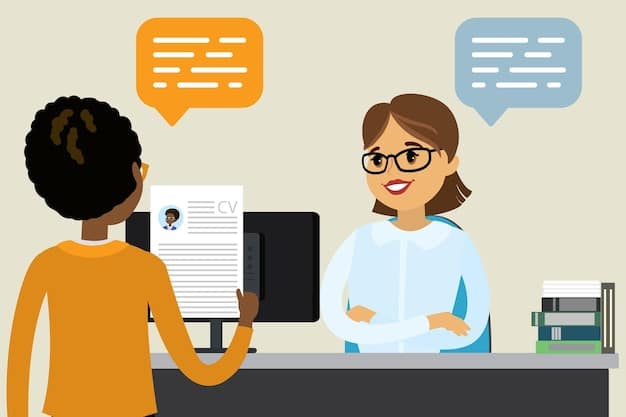Navigating Community Resource Eligibility Requirements: A Comprehensive Guide

Navigating the complexities of community resource eligibility requirements involves understanding various criteria, documentation needs, and application processes, all crucial for accessing essential support services and programs designed to assist individuals and families in need.
Accessing community resources can be a lifeline for individuals and families facing various challenges. However, navigating the complexities of community resource eligibility requirements can often feel like a daunting task. This guide aims to simplify the process, providing clarity and direction so you can effectively access the support you need.
Understanding the Landscape of Community Resources
Community resources encompass a wide array of services and programs designed to support individuals and families in various aspects of life. These resources can range from financial assistance and housing support to healthcare services and educational programs. Understanding the breadth of available resources is the first step in effectively navigating the eligibility process.
Knowing what’s out there helps you target your search and identify the specific resources that best meet your needs. This initial understanding is crucial for a streamlined and successful application process.
Types of Community Resources Available
Community resources are varied and cater to a wide range of needs. Here are some common categories you might encounter:
- Financial Assistance: Programs like SNAP (Supplemental Nutrition Assistance Program) and TANF (Temporary Assistance for Needy Families) offer financial support for food, housing, and other essential expenses.
- Housing Assistance: This includes subsidized housing, rental assistance programs, and resources for homeless individuals and families.
- Healthcare Services: Community health clinics, free or low-cost medical services, and assistance with accessing health insurance are crucial for maintaining well-being.
- Educational Programs: These range from early childhood education and tutoring services to adult education and job training programs.

In conclusion, having a broad understanding of the types of community resources available enables individuals to better identify and access the support systems tailored to their specific circumstances.
Key Factors Influencing Eligibility
Eligibility for community resources is determined by a variety of factors. These factors often vary depending on the specific program and the funding source. Understanding these key determinants is essential for preparing a successful application.
By being aware of the common eligibility factors, applicants can gather the necessary documentation and information to support their claims, thereby increasing their chances of approval.
Income Thresholds and Requirements
Income is a primary factor in determining eligibility for many community resources. Programs often have specific income thresholds, and applicants must demonstrate that their income falls below these limits. Here are some important considerations:
- Gross vs. Net Income: Understand whether the program considers gross (before taxes) or net (after taxes) income.
- Income Verification: Be prepared to provide documentation such as pay stubs, tax returns, and bank statements to verify your income.
- Income Limits: Check the specific income limits for the program you are applying to, as these can vary widely.
Residency Requirements
Many community resources require applicants to be residents of a specific city, county, or state. Be prepared to provide proof of residency, such as a driver’s license, utility bill, or lease agreement.
Other Eligibility Criteria
Beyond income and residency, other factors can influence eligibility for community resources. These may include:
- Age: Some programs are specifically designed for children, seniors, or other age-defined groups.
- Disability Status: Individuals with disabilities may be eligible for specific programs and services.
- Family Size: The number of individuals in your household can also affect eligibility.
In conclusion, it’s vital to understand all the factors that can influence eligibility for community resources, including income thresholds, residency requirements, and other specific criteria. This knowledge empowers applicants to prepare thoroughly and increase their chances of accessing the support they need.
Navigating the Application Process
The application process for community resources can be complex and often involves multiple steps. Understanding these steps and preparing accordingly can make the process smoother and more efficient.
A well-prepared application not only saves time but also demonstrates a proactive approach, which can positively influence the outcome.

Gathering Required Documentation
One of the most critical aspects of the application process is gathering the necessary documentation. Common documents include:
- Identification: Driver’s license, passport, or other government-issued ID.
- Proof of Income: Pay stubs, tax returns, and bank statements.
- Proof of Residency: Utility bills, lease agreements, or mortgage statements.
- Other Documents: Depending on the program, you may need to provide birth certificates, social security cards, or medical records.
Completing the Application Form
Carefully read and complete the application form. Pay attention to all instructions and ensure that you provide accurate and complete information.
Submitting the Application
Once you have completed the application and gathered all required documentation, submit the application according to the program’s instructions. This may involve mailing the application, submitting it online, or delivering it in person.
In conclusion, navigating the application process for community resources requires careful preparation and attention to detail. By gathering all required documentation, completing the application form accurately, and submitting it properly, applicants can significantly improve their chances of success.
Common Challenges and How to Overcome Them
Applicants often encounter various challenges when navigating the eligibility requirements for community resources. Recognizing these challenges and developing strategies to overcome them can make the process more manageable.
Anticipating potential obstacles and having proactive solutions can transform a frustrating experience into a successful one.
Understanding the common challenges faced during the eligibility navigation process can significantly increase the likelihood of a successful outcome.
Difficulty Understanding Eligibility Criteria
Eligibility criteria can be complex and difficult to understand. Here are some strategies for clarifying the requirements:
- Read the Program Guidelines: Carefully review the program guidelines and eligibility requirements.
- Contact the Program Directly: Reach out to the program administrators for clarification.
- Seek Assistance from Community Organizations: Many community organizations offer assistance with understanding eligibility requirements and completing applications.
Lack of Required Documentation
Gathering the necessary documentation can be challenging, especially if you are missing key documents. Here are some tips for obtaining required documents:
- Contact Relevant Agencies: Reach out to the agencies that issue the required documents, such as the Social Security Administration or the Department of Motor Vehicles.
- Gather Alternative Documentation: In some cases, alternative documentation may be accepted. Check with the program administrators to see if this is an option.
Language Barriers
Language barriers can make it difficult to understand eligibility requirements and complete applications. Here are some resources for overcoming language barriers:
- Translation Services: Many community organizations and government agencies offer translation services.
- Bilingual Staff: Look for programs that have bilingual staff who can assist you.
In conclusion, by understanding and actively addressing these common challenges, applicants can pave the way for a smoother and more successful journey in accessing essential community resources.
Appealing Denied Applications
If your application for community resources is denied, you have the right to appeal the decision. Understanding the appeals process and preparing a strong appeal can increase your chances of overturning the denial.
Knowing your rights and the steps to take in case of a denial empowers you to advocate for yourself and access the support you deserve.
Understanding the Reason for Denial
The first step in the appeals process is to understand the reason for the denial. Review the denial letter carefully and identify the specific reasons why your application was rejected.
Gathering Additional Documentation
If the denial was based on a lack of documentation, gather any additional documentation that supports your eligibility. This may include additional income statements, proof of residency, or medical records.
Submitting the Appeal
Submit the appeal according to the program’s instructions. Be sure to include all relevant documentation and clearly explain why you believe the denial was incorrect.
In conclusion, being equipped with knowledge on appealing denied applications provides individuals with a crucial pathway to challenge unfavorable decisions and ultimately access the community resources they are entitled to.
Staying Informed About Changes in Eligibility Requirements
Eligibility requirements for community resources can change over time due to changes in funding, regulations, or program priorities. Staying informed about these changes is essential for maintaining your eligibility and accessing the support you need.
Proactive awareness ensures that you continue to meet the criteria and can adapt to any modifications without losing access to vital assistance.
Monitoring Program Websites
Regularly check the websites of the programs you are interested in for updates on eligibility requirements.
Subscribing to Newsletters and Email Alerts
Many community organizations and government agencies offer newsletters and email alerts to keep you informed about changes in eligibility requirements.
Attending Community Meetings
Attend community meetings and forums to learn about changes in community resources and eligibility requirements.
In conclusion, the consistent effort to stay informed about changes in eligibility requirements ensures that individuals can proactively adapt, maintaining access to the essential community resources they rely on.
| Key Aspect | Brief Description |
|---|---|
| ℹ️ Understanding Resources | Recognizing the types of community support available. |
| 📝 Application Process | Steps for submitting applications effectively. |
| ❗ Addressing Challenges | Strategies for addressing common application obstacles. |
| 🔄 Staying Informed | Keeping up with changes in requirements. |
Frequently Asked Questions
▼
Common documents include identification, proof of income (like pay stubs or tax returns), and proof of residency (such as utility bills or lease agreements). Additional documents may be needed based on the specific program.
▼
If your application is denied, carefully review the denial letter to understand the reasons. Gather any additional documentation that supports your eligibility and submit an appeal according to the program’s instructions.
▼
Regularly check the websites of the programs you’re interested in, subscribe to newsletters or email alerts from community organizations and government agencies, and attend community meetings for updates.
▼
If you don’t meet all requirements, explore alternative programs that have different criteria. Contact local community organizations for assistance in identifying suitable resources and support options tailored to your specific situation.
▼
Yes, many community organizations offer assistance with completing complex application forms. These organizations can provide guidance, answer questions, and help ensure that your application is accurate and complete.
Conclusion
Navigating the complexities of community resource eligibility requirements can be challenging, but by understanding the key factors influencing eligibility, preparing a thorough application, and staying informed about changes, you can effectively access the support you need. Remember to seek assistance from community organizations and advocate for yourself throughout the process.





